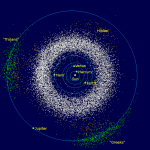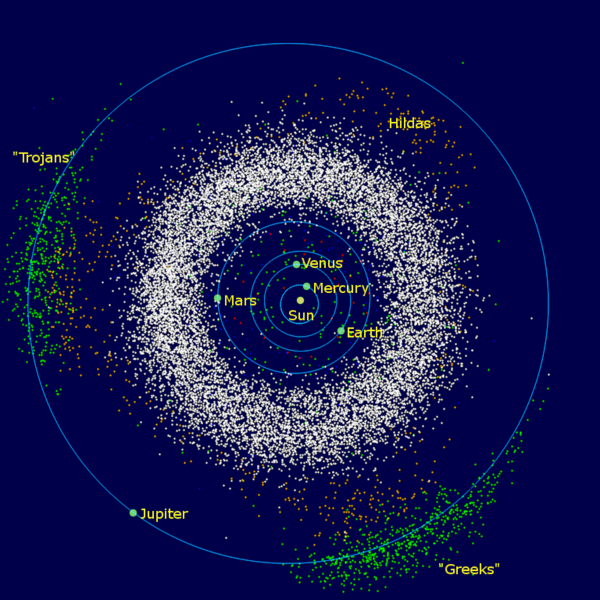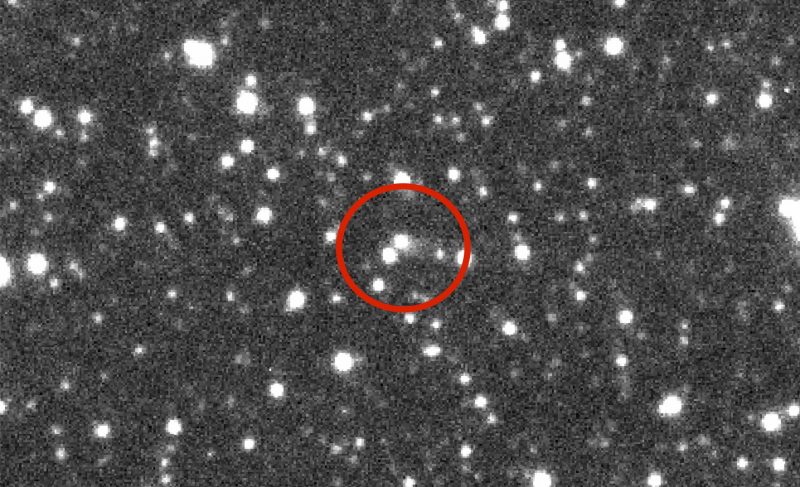

Astronomers use the name Trojan asteroid for all the asteroids collected at Jupiter’s 2 stable Lagrange points, 60 degrees ahead of the planet in its orbit and 60 degrees behind. They further divide them into 2 camps with the Greek camp orbiting in front of Jupiter, and the Trojan camp trailing behind. The newly discovered Trojan with a comet-tail is orbiting ahead of Jupiter. Image via Wikimedia Commons.
Scientific language is like a net thrown over nature. Scientists try to name and categorize natural objects, and usually that process goes smoothly … but sometimes it doesn’t, as in 2006 when Pluto was demoted from major planet to dwarf planet. Pluto didn’t change. Our understanding of Pluto’s context in our solar system had evolved. Asteroids and comets also sometimes defy easy categorization. There’s 3200 Phaethon, for example, which has an asteroid name, but which is the parent body for December’s Geminid meteor shower; if you follow meteor showers, you know they stem from comets. Astronomers are discovering more and more objects that start out looking like asteroids, and later develop activity, such as comet-like tails. Today (May 21, 2020), the Institute for Astronomy at the University of Hawai’i announced a new asteroid-with-a-comet-tail in a very interesting place in our solar system. This object is moving along the orbit traveled by Jupiter around our sun. It’s thus considered a Trojan asteroid, the first Trojan asteroid known with a comet-like tail. The University of Hawai’i explained:
Trojan asteroids follow the same orbit as a planet, but stay either around 60 degrees ahead or 60 degrees behind along the orbit. Earth has at least one Trojan asteroid, and Neptune has dozens. Jupiter has hundreds of thousands. The Jupiter Trojan asteroids orbit the sun in two huge swarms, one swarm orbiting ahead of the planet (where 2019 LD2 was found) and one swarm orbiting behind it. The Trojan asteroids have been captured into these orbits by Jupiter’s strong gravity.
The discovery comes from the Asteroid Terrestrial-impact Last Alert System (ATLAS), a NASA-funded project that uses wide-field telescopes to scan for asteroids that might pose an impact threat to Earth. You might remember comet C/2019 Y4 (ATLAS) from earlier this year; it’s one of more than 40 comets discovered by these same telescopes. It appeared to be getting brighter but then suddenly broke apart into multiple pieces, shattering our hopes for a cool comet show in the night sky. Comet do that sometimes; they break up as they near the sun.
They do that because comets are typically fragile, icy bodies, unlike asteroids, which tend to be rocky or metallic. That’s why comets, typically, have tails and asteroids don’t. The tails come from volatile materials – ices – within a comet’s central nucleus, or core. Solar radiation can vaporize these fragile materials, causing them to stream out of the nucleus, carrying dust with them, forming the comet’s tail.
Asteroids don’t do this, typically. They typically don’t have the ices that become comet tails. But, as stated above, the lines sometimes blur. University of Hawai’i reported:
Early in June 2019, ATLAS reported what seemed to be a faint asteroid near the orbit of Jupiter. The Minor Planet Center designated the new discovery as 2019 LD2. Inspection of ATLAS images taken on June 10 by collaborators Alan Fitzsimmons and David Young at Queen’s University Belfast revealed its probable cometary nature. Follow-up observations by the University of Hawai?i’s J.D. Armstrong and his student Sidney Moss on June 11 and 13 using the Las Cumbres Observatory (LCO) global telescope network confirmed the cometary nature of this body.
Later, in July 2019, new ATLAS images caught 2019 LD2 again – now truly looking like a comet, with a faint tail made of dust or gas. The asteroid passed behind the sun and was not observable from the Earth in late 2019 and early 2020, but upon its reappearance in the night sky in April of 2020, routine ATLAS observations confirmed that it still looks like a comet. These observations showed that 2019 LD2 has probably been continuously active for almost a year.
And that’s interesting, too, because we don’t tend to think of cometary activity as something ongoing. It tends to happen when comets draw in near the sun. The volatile material leaves the comet’s surface, forming the tail and then, at some point, it’s used up. For 2019 LD2, the continuous activity for a year of observation prompts some questions. How long has this object been doing this? Why didn’t astronomers see this object before this?

Image of asteroid 2019 LD2 taken on June 11, 2019, using the Las Cumbres Observatory Global Telescope (LCOGT) Networks 1.0-meter telescope at Cerro Tololo, Chile. Image via JD Armstrong/ LCOGT/ IfA.
One answer may be that it only recently got to the place where we now see it. The astronomers’ statement said:
What makes 2019 LD2 so interesting is that we think most Jupiter Trojans were captured billions of years ago. Any surface ice that could vaporize to spew out gas and dust should have done so long ago, leaving the objects quietly orbiting as asteroids – not behaving like comets.
What could have made 2019 LD2 suddenly show cometary behavior? Maybe Jupiter captured it only recently from a more distant orbit where surface ice could still survive.
Or, there’s another possibility, one that has astronomers excited. This object could be revealing that, as predicted by some astronomers, the Trojan asteroids may be icier than your average asteroid. Alan Fitzsimmons said:
.
We have believed for decades that Trojan asteroids should have large amounts of ice beneath their surfaces, but never had any evidence until now. ATLAS has shown that the predictions of their icy nature may well be correct.
These astronomers said the comet-tail might be showing up now because 2019 LD2 recently suffered a landslide or an impact from another asteroid, exposing ice that used to be buried under layers of protective rock. The astronomers said:
New observations to find out are being acquired and evaluated.
What’s certain is that the universe is full of surprises – and surveys to guard the Earth from dangerous asteroids often make unexpected discoveries of harmless but fascinating objects that can reveal more about our solar system’s history.
Bottom line: Trojan asteroids orbit 60 degrees ahead of and behind Jupiter, in its wide orbit at 5 times Earth’s distance from the sun. Now the 1st Trojan asteroid – called 2019 LD2 – has been found with a comet-like tail.
from EarthSky https://ift.tt/36llsr4


Astronomers use the name Trojan asteroid for all the asteroids collected at Jupiter’s 2 stable Lagrange points, 60 degrees ahead of the planet in its orbit and 60 degrees behind. They further divide them into 2 camps with the Greek camp orbiting in front of Jupiter, and the Trojan camp trailing behind. The newly discovered Trojan with a comet-tail is orbiting ahead of Jupiter. Image via Wikimedia Commons.
Scientific language is like a net thrown over nature. Scientists try to name and categorize natural objects, and usually that process goes smoothly … but sometimes it doesn’t, as in 2006 when Pluto was demoted from major planet to dwarf planet. Pluto didn’t change. Our understanding of Pluto’s context in our solar system had evolved. Asteroids and comets also sometimes defy easy categorization. There’s 3200 Phaethon, for example, which has an asteroid name, but which is the parent body for December’s Geminid meteor shower; if you follow meteor showers, you know they stem from comets. Astronomers are discovering more and more objects that start out looking like asteroids, and later develop activity, such as comet-like tails. Today (May 21, 2020), the Institute for Astronomy at the University of Hawai’i announced a new asteroid-with-a-comet-tail in a very interesting place in our solar system. This object is moving along the orbit traveled by Jupiter around our sun. It’s thus considered a Trojan asteroid, the first Trojan asteroid known with a comet-like tail. The University of Hawai’i explained:
Trojan asteroids follow the same orbit as a planet, but stay either around 60 degrees ahead or 60 degrees behind along the orbit. Earth has at least one Trojan asteroid, and Neptune has dozens. Jupiter has hundreds of thousands. The Jupiter Trojan asteroids orbit the sun in two huge swarms, one swarm orbiting ahead of the planet (where 2019 LD2 was found) and one swarm orbiting behind it. The Trojan asteroids have been captured into these orbits by Jupiter’s strong gravity.
The discovery comes from the Asteroid Terrestrial-impact Last Alert System (ATLAS), a NASA-funded project that uses wide-field telescopes to scan for asteroids that might pose an impact threat to Earth. You might remember comet C/2019 Y4 (ATLAS) from earlier this year; it’s one of more than 40 comets discovered by these same telescopes. It appeared to be getting brighter but then suddenly broke apart into multiple pieces, shattering our hopes for a cool comet show in the night sky. Comet do that sometimes; they break up as they near the sun.
They do that because comets are typically fragile, icy bodies, unlike asteroids, which tend to be rocky or metallic. That’s why comets, typically, have tails and asteroids don’t. The tails come from volatile materials – ices – within a comet’s central nucleus, or core. Solar radiation can vaporize these fragile materials, causing them to stream out of the nucleus, carrying dust with them, forming the comet’s tail.
Asteroids don’t do this, typically. They typically don’t have the ices that become comet tails. But, as stated above, the lines sometimes blur. University of Hawai’i reported:
Early in June 2019, ATLAS reported what seemed to be a faint asteroid near the orbit of Jupiter. The Minor Planet Center designated the new discovery as 2019 LD2. Inspection of ATLAS images taken on June 10 by collaborators Alan Fitzsimmons and David Young at Queen’s University Belfast revealed its probable cometary nature. Follow-up observations by the University of Hawai?i’s J.D. Armstrong and his student Sidney Moss on June 11 and 13 using the Las Cumbres Observatory (LCO) global telescope network confirmed the cometary nature of this body.
Later, in July 2019, new ATLAS images caught 2019 LD2 again – now truly looking like a comet, with a faint tail made of dust or gas. The asteroid passed behind the sun and was not observable from the Earth in late 2019 and early 2020, but upon its reappearance in the night sky in April of 2020, routine ATLAS observations confirmed that it still looks like a comet. These observations showed that 2019 LD2 has probably been continuously active for almost a year.
And that’s interesting, too, because we don’t tend to think of cometary activity as something ongoing. It tends to happen when comets draw in near the sun. The volatile material leaves the comet’s surface, forming the tail and then, at some point, it’s used up. For 2019 LD2, the continuous activity for a year of observation prompts some questions. How long has this object been doing this? Why didn’t astronomers see this object before this?

Image of asteroid 2019 LD2 taken on June 11, 2019, using the Las Cumbres Observatory Global Telescope (LCOGT) Networks 1.0-meter telescope at Cerro Tololo, Chile. Image via JD Armstrong/ LCOGT/ IfA.
One answer may be that it only recently got to the place where we now see it. The astronomers’ statement said:
What makes 2019 LD2 so interesting is that we think most Jupiter Trojans were captured billions of years ago. Any surface ice that could vaporize to spew out gas and dust should have done so long ago, leaving the objects quietly orbiting as asteroids – not behaving like comets.
What could have made 2019 LD2 suddenly show cometary behavior? Maybe Jupiter captured it only recently from a more distant orbit where surface ice could still survive.
Or, there’s another possibility, one that has astronomers excited. This object could be revealing that, as predicted by some astronomers, the Trojan asteroids may be icier than your average asteroid. Alan Fitzsimmons said:
.
We have believed for decades that Trojan asteroids should have large amounts of ice beneath their surfaces, but never had any evidence until now. ATLAS has shown that the predictions of their icy nature may well be correct.
These astronomers said the comet-tail might be showing up now because 2019 LD2 recently suffered a landslide or an impact from another asteroid, exposing ice that used to be buried under layers of protective rock. The astronomers said:
New observations to find out are being acquired and evaluated.
What’s certain is that the universe is full of surprises – and surveys to guard the Earth from dangerous asteroids often make unexpected discoveries of harmless but fascinating objects that can reveal more about our solar system’s history.
Bottom line: Trojan asteroids orbit 60 degrees ahead of and behind Jupiter, in its wide orbit at 5 times Earth’s distance from the sun. Now the 1st Trojan asteroid – called 2019 LD2 – has been found with a comet-like tail.
from EarthSky https://ift.tt/36llsr4

Aucun commentaire:
Enregistrer un commentaire